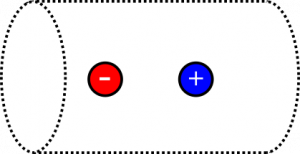This is an old revision of the document!
Example: Flux from a Dipole
Suppose you have a two charges, one with value $5 \mu\text{C}$, the other with value $5 \mu\text{C}$. There are at separate locations, a distance $1 \text{ m}$ apart, and they can be modeled as a dipole. What is the flux through a cylinder with radius $4 \text{ m}$ and length $16 \text{ m}$ that encloses this dipole?
Facts
- The dipole charges are $q=5 \mu\text{C}$, $-q=-5 \mu\text{C}$.
- The dipole distance is $1 \text{ m}$.
- The cylinder has radius $4 \text{ m}$ and length $16 \text{ m}$.
Lacking
- $\Phi_e$ through the cylinder
Approximations & Assumptions
- The axis of the cylinder is aligned with the dipole.
- The dipole and cylinder are centered with respect to each other.
- The electric flux through the cylinder is due only to the dipole (i.e., no other charges exist).
- The charges are point charges, which indeed means we can model them as a dipole.
Representations
Solution
First, notice that
